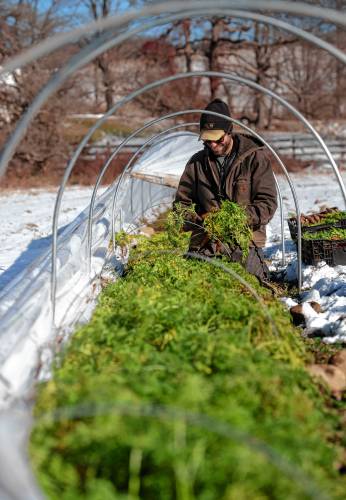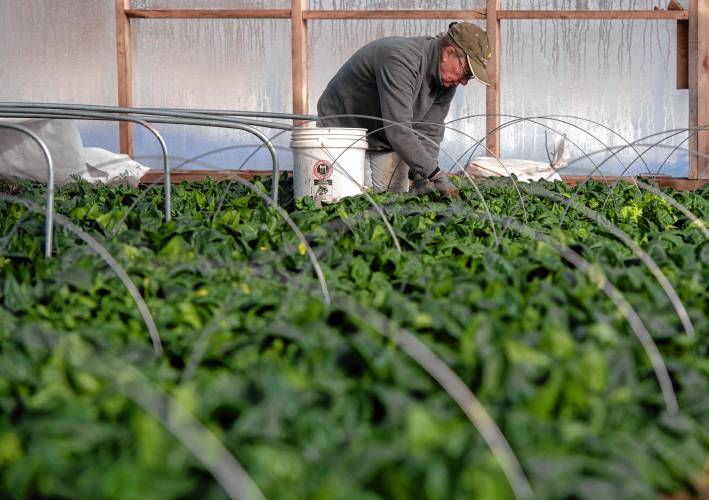Valley Bounty: Farming in a winter wonderland: Lombrico Farm in Whately coaxes fresh produce from soil year-round
| Published: 01-19-2024 11:07 AM |
‘The best carrots you’ll ever eat are picked in January or February,” says Erik Debbink, owner of Lombrico Farm in Whately. In the dead of winter, their sweetness shines through.
Lombrico Farms is one of a growing number of local farms working hard to coax fresh produce from their soil throughout the winter. Through traditional sales channels and a farm to food access partnership with the Hilltown CDC, Lombrico Farms is putting their harvest on as many plates as possible.
“Our aim is to grow seasonally appropriate food year-round, with organic methods and without any supplemental heat or light,” explains Debbink. “We focus on resilience and creating more access for our community.”
The farm consists of two acres of mixed vegetables and another two of fruit and nut trees. The eight-acre property offers room to expand, though right now Debbink has his hands full as the sole full time farmer. His path here was not paved by family tradition, but rather his own curiosity and many years of learning while doing.
“I started at Prospect Meadow Farm, a therapeutic vocational farm in Hatfield, in 2012,” he explains. “I’d done some mental health support work, and Shawn Robinson (now the vice president of vocational services and day programs at ServiceNet, which runs the farm) took a chance on me as farm manager.”
After several years there, Debbink shifted to Bird Haven Farm in Southampton, managing their blueberry orchard, before he and his partner moved to England, where he spent four years overseeing a large market garden and selling to restaurants in London. While there, the couple began searching for land in the Valley to start their own operation. Despite several false starts and a global pandemic, they finally closed on land and moved back in 2021. Within a year, Lombrico Farm was up and running.
“I knew western Massachusetts was where I wanted to start my own farm,” says Debbink. “There’s so much love in this area for local farmers. Whether it’s support from CISA (Community Involved in Sustaining Agriculture) or hearing farmers interviewed on the radio, like their voices matter, it feels good knowing people are invested in farmers’ success.”
When it comes to winter growing, Debbink is drawn in both by the technical challenge of it and the opportunities it poses. For one, the supply of local food in the Valley is lower in winter compared to other times of year but the demand is mostly steady, creating a business opportunity. There’s also a resilience argument for investing in the equipment needed for cold weather farming.
Article continues after...
Yesterday's Most Read Articles
As Debbink puts it, “in a world of climate disruptions, covered growing space is becoming like gold.” Whether it’s large plastic-sheathed high tunnels and hoop houses or smaller structures that shelter individual rows of plants, more Massachusetts farmers are planting underneath equipment that gives protection from the elements and more control over growing conditions. If farms have this equipment already, extending the growing season or even growing year-round becomes much easier, and a smart way to make the most of that investment.
Debbink also thinks increasing winter production is a straightforward way of increasing the total amount of local food we eat in New England. If local farmers’ harvests can take the place of food shipped in from elsewhere, local consumption goes up, regardless of customers’ buying habits.
“I think New England Feeding New England’s vision of 30% local food consumption by 2030 initiative is a great goal,” he says. “There’s no reason we can’t grow all our fresh carrots in Massachusetts in the winter, so Big Y doesn’t need to buy them from California. Obviously, there are economies of scale and logistics to work out, but absolutely it can be done.”
On his farm, Debbink uses a combination of high tunnels, low tunnels, and different insulating coverings to protect crops throughout the winter without artificial heat. This saves money, resources, and potential emissions. Leafy greens are a staple, with spinach, lettuce, kale, and more growing sheltered under a high tunnel. He has also found success with cold hardy scallions, and of course carrots.
“We’re one of the few farms growing carrots all winter without heat, but it’s very doable and they taste incredible,” he says. “Every time it drops below freezing, they get sweeter as the plant consolidates sugars into the root to keep it from freezing.”
According to Debbink, maintaining a winter-long harvest in the northeast is all about dialing in the timing, because most crops grow much slower with a shorter daylight window. “We start stuff in late summer or early fall so it matures,” he says, “and then really we’re holding it to harvest through the winter. Once we get longer days in February and March, things start growing faster.”
Most of Lombrico Farm’s produce is sold wholesale through Green Fields Market in Greenfield, McCusker’s Market in Shelburne Falls, and the Hilltown Mobile Market run by the Hilltown CDC. They are also a vendor at the year-round Easthampton Farmers, currently running every other Sunday, 10 a.m. to 2 p.m. in the Eastworks building at 116 Pleasant St. The next market will be Sunday January 21st.
In addition, Lombrico Farm recently joined as a farm partner in the Hilltown CDC’s newer farm to food access program, funded by a $75,000 US Department of Agriculture Food Purchase Assistance Cooperative Agreement grant.
“This is a really great program that pays farmers close to retail price to distribute food to people who may not otherwise have access to it,” says Debbink. “It’s been really easy to participate. I just add my two drop off points, the Goshen Survival Center and Williamsburg Council on Aging, to my delivery route, and then send invoices to Hilltown CDC.”
Whether it’s rethinking the links between farmers and eaters or testing the boundaries of the farming seasons, “I think we’re at the forefront of some radical shifts in thinking,” says Debbink, “and that’s really exciting.”
Jacob Nelson is communications coordinator for CISA. To learn more about local farms and where to find local food in your community, visit buylocalfood.org.









 Speaking of Nature: Capturing my Bermuda nemesis: The Great Kiskadee nearly evaded me, until I followed its song
Speaking of Nature: Capturing my Bermuda nemesis: The Great Kiskadee nearly evaded me, until I followed its song Easthampton author Emily Nagoski has done the research: It’s OK to love your body
Easthampton author Emily Nagoski has done the research: It’s OK to love your body Earth Matters: Honoring a local hero: After 40 years, Hitchcock Center bids farewell to educator and creative leader, Colleen Kelley
Earth Matters: Honoring a local hero: After 40 years, Hitchcock Center bids farewell to educator and creative leader, Colleen Kelley Valley Bounty: Delivering local food onto students’ plates: Marty’s Local connects farms to businesses
Valley Bounty: Delivering local food onto students’ plates: Marty’s Local connects farms to businesses
